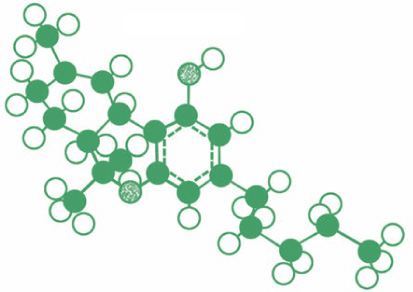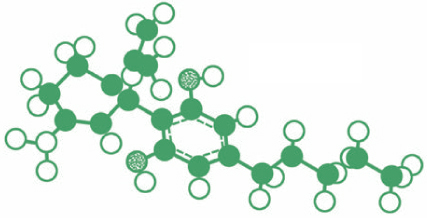More than 700 chemical constituents are produced within the cannabis plant.31 Of these, the cannabinoids, a group of over 80 molecules with chemical structures called terpenophenolics, have attracted the most interest from medical researchers. Cannabinoids are molecules that interact with cannabinoid receptors; receptor protein molecules are found throughout the bodies of plants and animals. The body produces its own cannabinoids in the form of endocannabinoids. By contrast, phytocannabinoids are cannabinoids produced by the cannabis plant in the form of carboxylic acids: THCA, CBDA, and so on. Upon heating, or gradually warming up to room temperature over time, these cannabinoid acids are converted to their chemically neutral and more widely known form: THC, CBD, etc. It is this neutral form of THC that is psychoactive in humans. Cannabinoids have extremely high lethal dose requirements in humans, which is why no fatal overdose has ever been directly attributable to cannabinoids. Until very recently, phytocannabinoids referred solely to those cannabinoids that are produced by the cannabis plant. More recently, however, it has been discovered that compounds produced by other plants, including lichens and even black pepper, can interact with cannabinoid receptors as well; therefore the definition of phytocannabinoids has been expanded to include any natural plant compounds that interact with cannabinoid receptors. For much of the last 100 years, a small handful of cannabinoids were thought to be the only active pharmacological constituents of cannabis. But over the last decade, researchers have tried to get to the bottom of why different varieties of herbal cannabis appear to produce differing medicinal or psychoactive effects. One explanation for the variation is a synergy between cannabinoids and other components of cannabis’ essential oil, called terpenoids or terpenes. It is now believed that both cannabinoids and terpenes, acting in concert, are responsible for the differences in both medicinal and psychoactive effects produced by cannabis varieties. While there are over 100 cannabinoids produced by cannabis, only a few are produced in any significant quantity. They can be categorized into 10 structural types, of which four are primary: A fifth type, CBN (cannabinol), is not produced by the plant but results from the oxidation of THC as it breaks down. THC Delta-9-tetrahydrocannabinolic acid or THCA is the most common phytocannabinoid produced by drug cannabis varieties. Certain varieties of drug cannabis can produce up to 25 percent of the plant’s dry weight in THC acid—an extraordinary amount for a single secondary metabolite in any plant species. The production of THC within the plant is controlled by a small group of genes. These genes controlling THC production are dominant in most drug forms of cannabis. THC is produced by an enzyme reaction within the plant using CBG as its precursor (see this page). THC is the primary psychoactive constituent of cannabis, although in its raw acidic form within the plant, it is not at all psychoactive. Upon heating through smoking, vaporization, or cooking, THCA is converted (decarboxylated) into THC (see this page) and becomes highly psychoactive. Besides its psychoactivity, THC is a potent anti-inflammatory and analgesic,32 is neuroprotective,33 and reduces intraocular pressure, spasticity, and muscle tension.34 THC interacts with both the CB1 and CB2 endocannabinoid receptors. While THC is nontoxic, some physicians have characterized the unpleasant effects of THC overdoses as “psychotoxic.” For example, THC can produce anxiety, sedation, and rapid heartbeat in novice users—although some of these adverse effects can decline over a course of treatment. High doses of THC over time are linked to receptor downregulation and tolerance to its effects. THC Molecule CBD Cannabidiolic acid or CBDA is the most common phytocannabinoid produced by fiber cannabis (hemp) varieties, and the second most common in some drug cannabis varieties. CBDA can be converted to CBD by heat over time, like THC. However, there are preliminary indications that CBD blood plasma levels are more easily achieved by using CBDA, rather than decarboxylated CBD. This study contradicts our current understanding of how cannabinoids work and more research needs to be conducted to confirm this assertion.35 CBD is produced from CBG, like THC, but employs a different set of genes and a different enzymatic reaction. Until recently, high-CBD cannabis varieties were unavailable in medical cannabis outlets in the United States. But with the advent of advocacy groups such as Project CBD, high-CBD cannabis varieties have reemerged in California and Colorado after testing laboratories began to screen for them. For example, a cannabis variety from Spain named Cannatonic has recently become available in California; it has a 20 to one CBDA to THCA ratio and peak dry weight concentrations approaching 17 percent CBDA. Varieties such as Cannatonic should dramatically increase the availability of CBD-dominant cannabis within the medical cannabis community. While CBD is not classically psychoactive, patients using high-CBD herbal cannabis have noted some effects akin to mild psychoactivity, though subjectively very different from THC-dominant cannabis. In cannabis medicine formulations that combine THC and CBD, such as Sativex, CBD has been shown to eliminate some of THC’s unpleasant adverse effects, modulating its psychoactivity and reducing the incidence of THC-induced sedation, anxiety, and rapid heartbeat.36 Sativex appears to demonstrate the strong synergy between CBD and THC. For example, in a Sativex study conducted with cancer patients suffering from intractable pain, CBD and THC in combination reduced this pain significantly, while THC alone did not. CBD exhibits analgesic and anti-inflammatory effects across a wide range of symptoms and conditions. Cell studies have shown that CBD is also effective in vitro against lines of human brain, breast, and other tumor cells, while simultaneously protecting normal cells. CBD, along with its propyl cousin CBDV, is an effective anticonvulsant.37 CBD interacts with a wide range of receptors—more than THC—which may explain its broad effects. While CBD dosen’t interact with CB1 and CB2, it does interact with a host of other signaling systems.38 These interactions may lead to CBD-based treatments for conditions ranging from strokes to acne. CBD is even effective in inhibiting methicillin-resistant Staphylococcus aureus (MRSA; an infection-causing bacterium strain), more so than the antibiotic vancomycin.
PHYTOCANNABINOIDS AND TERPENOIDS—THE PRINCIPAL ACTIVE INGREDIENTS OF MEDICINAL CANNABIS
Cannabinoids


and terpenoids—The Principal Active Ingredients of Medicinal Cannabis
Only gold members can continue reading. Log In or Register to continue

Full access? Get Clinical Tree


